간행물
인문과학논집

- 발행기관 강남대학교 인문과학연구소
- 자료유형 학술지
- 간기 반년간
- ISSN 1226-5349 (Print)
- 수록기간 1996 ~ 2014
- 주제분류 인문학 > 기타인문학 인문학 분류의 다른 간행물
- 십진분류KDC 001DDC 000
권호리스트/논문검색
제18집 (2008년 2월) 9건
1.
2008.02
구독 인증기관 무료, 개인회원 유료
現代西歐社會와 美國의 境遇社會福社의 目標는 ‘모든 인간의 幸福’에 있으며, 이러한 社會福社의 목표는 社會福社의 4가지 原理에 그 基盤을 두고 있는데, ‘인간의 尊嚴性’, ‘자기 결정권’, ‘기회평등의 구현’ 및 ‘사회적 책임’이 그것이다. 天主敎의 社會福社분야에 대한 중심교리는 성서의 “하느님의 형상대로 사람을 창조하시고 .... " (創世記 27.)는 부분에 근원을 두고 있다. 하느님의 모습으로 인간이 창조되었기 때문에 ‘인간의 가치와 존엄성’은 당연히 보장되어야 하며, 하느님 앞에서는 평등하다는 ‘평등사상’이 내포되어 있다. 또한 하느님과 인간의 관계는 인간은 자신의 모든 행동에 대해 스스로 결정하고 하느님 앞에 책임을 져야한다는 사상이며, 인간의 고통은 죄의 결과로서 자신이 지은 죄로 자신이 고통을 받는 경우도 있지만 대부분 자신의 죄로 말미암아 남을 고통스럽게 하므로 인간의 고통은 연대성 및 공동체성을 가지고 있다는 ‘사회적 책임’등 천주교의 사회교리에는 現代西歐社會福社의 모든 가치가 다 내포되어 있다. 본 고에서는 천주교의 사회복지활동은 보다 ‘낮은 곳을 향하여’, ‘보다 더 손길이 필요한 곳을 향하여’ 노력하고 있음이 통계적 자료를 통해서도 확인되고 있음을 보여 주고 있다.
4,600원
2.
2008.02
구독 인증기관 무료, 개인회원 유료
6,300원
3.
2008.02
구독 인증기관 무료, 개인회원 유료
4,600원
4.
2008.02
구독 인증기관 무료, 개인회원 유료
5,800원
5.
2008.02
구독 인증기관 무료, 개인회원 유료
김혜순의 시론집『여성이 글을 쓴다는 것은』은 ‘여성성’과 ‘시작(詩作)’의 관계를 본격적이고 심층적으로 탐색한 저작이다. 여성성은 인간성의 반쪽이 아니라 근본적인 차원이다. 김혜순은 여성성을 부정하는 방식을 부정하면서, 여성성을 글쓰기의 근본적이고 심층적인 차원에서 드러내고 또한 미학적인 원리로 내세운다 김혜순이 사유하는 여성성의 핵심적인 자질은 생성의 능력이라 하겠다. 시적 주체의 엔트로피와 운동성은 여기에서 나온다. 김혜순이 시쓰기에 ‘바리데기’를 호명했던 이유 또한 여기에서 찾을 수 있었다. ‘바리데기-되기’, ‘어머니-되기’는 은폐된 타자들을 해방시키고 활성화하는, 이를테면 타자들을 낳는 ‘자궁-되기’와 같은 것이었다. 김혜순에게 삶과 죽음, 현실과 환상, 나와 타자, 주체와 세계는 안과 밖의 이원론적 구조가 아니라 표면과 심층의 일원론적 관계 속에서 개시된다. 이를 ‘외부의 내재성’, ‘초월의 내재성’ 같은 말로 표현해 볼 수 있다. 내가 내 바깥의 타자들을 포획하고 규정하는 방식의 동일시가 아니라, 어머니가 아이를 생산하듯이 내 안에서 타자들을 출산하고 폭발시키면서 ‘나’를 바꾸는 방식으로 ‘시-하기’는 이루어진다. 이러한 ‘시-하기’는 내 안에서 숨겨진 ‘어머니’를 찾는 것이면서 ‘어머니’를 거꾸로 출산하는 것이기도 하다. 김혜순은 자아 중심의 기존 시학을 부정하면서 타자성의 시학을 제출한다. 그녀에게 ‘시-하기’는 ‘자아 지우기’이며 고체의 몸을 유동적인 액체의 형질로 바꾸는 사건들이라고 할 수 있다. 그녀의 시론에서 떠오르는 것은 타자에 대한 시선의 문제가 아니라 타자를 낳고 경험하는 몸의 사건, 즉 자아와 타자가 접촉하고 섞이는 사건이다. 시의 장르적 원리로 간주되어 왔던 ‘세계의 자아화’라는 정의에 대하여 김혜순이 강력하게 수정을 요구할 때, 아니 이러한 시론의 요구 이전에 이미 ‘시-하기’는 이 관습적인 울타리에 갇히지 않고 ‘세계와 자아가 함께 동참한 소용돌이’, 나와 타자의 접촉 속에서 자유를 실천해왔다고 할 수 있을것이다.
5,500원
6.
2008.02
구독 인증기관 무료, 개인회원 유료
본 연구는 한국에 있어서의 복지국가 발전과정을 정치적, 경제적 사회적 요인을 통하여 고찰하였다. 즉, 본 연구는 역사적 변천과정에 따른 한국의 사회복지의 변화상을 비교 분석하여, 향후 한국의 사회복지 발전방안을 제시하는데 필요한 기초자료를 제공하고자 한다.
6,300원
7.
2008.02
구독 인증기관 무료, 개인회원 유료
4,600원
8.
2008.02
구독 인증기관 무료, 개인회원 유료
This study reviewed the lives of maids of honor, the members of the court who assisted the royal family during Korea’s feudal monarchy, through the definitive Joseon Dynasty court literatures Gyechukilgi, Inhyeonwanghujeon, and Hanjungnok. Maids of honor originate from Tianguan Zhouzai (Celestial Ministry with the Prime Minister) chapter of China’s Zhouli (Rites of the Zhou). And because Korea was a dynasty, it is believed that maids of honor were part of the court since founding of the state, despite the lack of concrete records supporting the assumption. However, a mural painting from a tomb that dates back to the Goguryeo era does confirm the presence of maids of honor during its time. Details of the maid of honor hierarchy have been discovered through Samguksagi Japji’s Shila volume and records from Goryeo’s age of Hyeongjong, but it was officially organized during Joseon Dynasty’s age of Taejong. The official title of maids of honor was the royal court lady, which means someone who assists the royal family. Maids of honor had to spend their entire lives within the enclosed walls of the royal palace, and this explains why they are also called Gungin, Naein, or Nain. In addition, maids of honor included apprentice maids without an official rank and waiting women to the court ladies whose job it was to handle odd jobs. Responsibilities of the maids of honor were divided into jimil, docheong, and cheoso. Aside from these responsibilities of the systemized maid of honor hierarchy, specific tasks were assigned to servants of the royal nurse and maids of honor and servants assigned to assist the management of the palace and the royal family and their chambers outside the royal palace. Having been chosen out of a group of servants that were officially part of the king’s assets or a group of servants assigned to the government, maids of honor were people of a humble status. However, when a maid of honor became an official court lady after fifteen years of servitude at the royal palace, she was assigned with a level 9 official rank and received the corresponding wage. Then, after ten or twenty more years, she became a level 5 sangung, managing many servants under her and enjoying a specialist position that worked in shifts. As such, maids of honor silently continued on the tradition as masters of their various fields and played a leading role in the cultural epitome that is the royal court culture.
8,000원
9.
2008.02
구독 인증기관 무료, 개인회원 유료
본 연구는 네팔의 특수교육 현황을 소개함에 목적이 있다. 40년간 진행되어온 네팔 장애 학생을 위한 교육 프로그램의 내용과 프로그램의 근간이 되고 있는 법적, 행정적 체계에 대하여 소개하였다. 또한 현재 네팔 특수교육의 발전을 저해하는 문제점 중 하나인 전문적인특수교사의 부족과 향후 전문가 양성과정의 개선 방향에 관하여 언급하였다. 본 연구는 제3 세계 특수교육 지원을 위한 보다 효과적인 지원 프로그램을 모색하는데 도움을 주고자 한다.
5,100원

